基础中医英语
- 格式:doc
- 大小:124.50 KB
- 文档页数:20
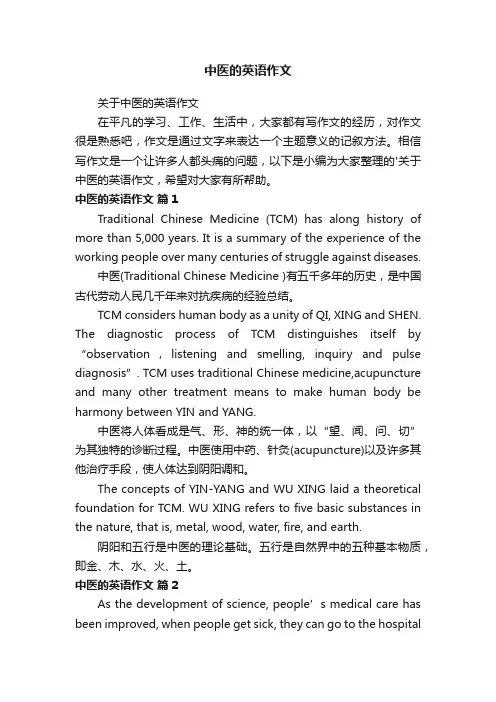
中医的英语作文关于中医的英语作文在平凡的学习、工作、生活中,大家都有写作文的经历,对作文很是熟悉吧,作文是通过文字来表达一个主题意义的记叙方法。
相信写作文是一个让许多人都头痛的问题,以下是小编为大家整理的'关于中医的英语作文,希望对大家有所帮助。
中医的英语作文篇1Traditional Chinese Medicine (TCM) has along history of more than 5,000 years. It is a summary of the experience of the working people over many centuries of struggle against diseases.中医(Traditional Chinese Medicine )有五千多年的历史,是中国古代劳动人民几千年来对抗疾病的经验总结。
TCM considers human body as a unity of QI, XING and SHEN. The diagnostic process of TCM distinguishes itself by “observation,listening and smelling, inquiry and pulse diagnosis”. TCM uses traditional Chinese medicine,acupuncture and many other treatment means to make human body be harmony between YIN and YANG.中医将人体看成是气、形、神的统一体,以“望、闻、问、切”为其独特的诊断过程。
中医使用中药、针灸(acupuncture)以及许多其他治疗手段,使人体达到阴阳调和。
The concepts of YIN-YANG and WU XING laid a theoretical foundation for TCM. WU XING refers to five basic substances in the nature, that is, metal, wood, water, fire, and earth.阴阳和五行是中医的理论基础。
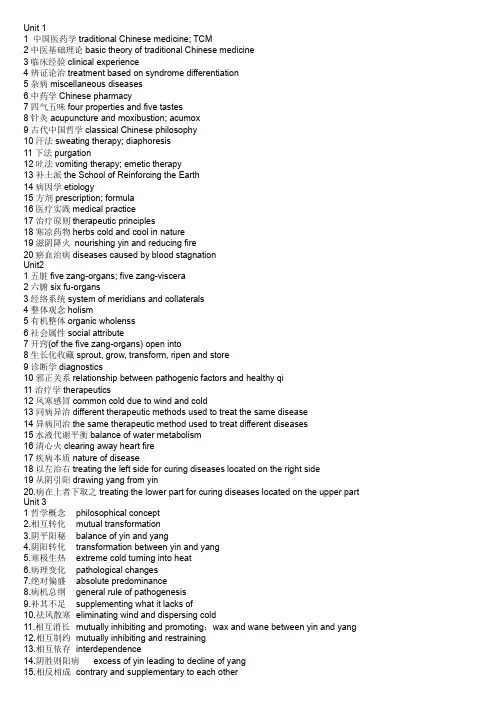
Unit 11 中国医药学traditional Chinese medicine; TCM2中医基础理论basic theory of traditional Chinese medicine3临床经验clinical experience4辨证论治treatment based on syndrome differentiation5杂病miscellaneous diseases6中药学Chinese pharmacy7四气五味four properties and five tastes8针灸acupuncture and moxibustion; acumox9古代中国哲学classical Chinese philosophy10汗法sweating therapy; diaphoresis11下法purgation12吐法vomiting therapy; emetic therapy13补土派the School of Reinforcing the Earth14病因学etiology15方剂prescription; formula16医疗实践medical practice17治疗原则therapeutic principles18寒凉药物herbs cold and cool in nature19滋阴降火nourishing yin and reducing fire20瘀血治病diseases caused by blood stagnationUnit21五脏five zang-organs; five zang-viscera2六腑six fu-organs3经络系统system of meridians and collaterals4整体观念holism5有机整体organic wholenss6社会属性social attribute7开窍(of the five zang-organs) open into8生长化收藏sprout, grow, transform, ripen and store9诊断学diagnostics10邪正关系relationship between pathogenic factors and healthy qi11治疗学therapeutics12风寒感冒common cold due to wind and cold13同病异治different therapeutic methods used to treat the same disease14异病同治the same therapeutic method used to treat different diseases15水液代谢平衡balance of water metabolism16清心火clearing away heart fire17疾病本质nature of disease18以左治右treating the left side for curing diseases located on the right side19从阴引阳drawing yang from yin20.病在上者下取之treating the lower part for curing diseases located on the upper part Unit 31哲学概念philosophical concept2.相互转化mutual transformation3.阴平阳秘balance of yin and yang4.阴阳转化transformation between yin and yang5.寒极生热extreme cold turning into heat6.病理变化pathological changes7.绝对偏盛absolute predominance8.病机总纲general rule of pathogenesis9.补其不足supplementing what it lacks of10.祛风散寒eliminating wind and dispersing cold11.相互消长mutually inhibiting and promoting;wax and wane between yin and yang12.相互制约mutually inhibiting and restraining叮叮小文库16.有机整体organic whole17.阳损及阴impairment of yang involving yin18.阴阳两虚deficiency of both yin and yang19.虚寒证deficiency cold syndrome20.潜阳熄风suppressing yang and eliminating windUnit41 the theory of five elements 五行学说2 free development 条达舒畅3 to be generated and to generate生我,我生4 restraint in generation 生中有制5 over restriction and counter-restriction相乘相侮6 Wood over restricts earth because it is deficient.土虚木乘7 promotion, restriction, inhibition and transformation 生克制化8 disorder of a mother-organ involving its child-organ 母病及子9 insufficiency of essence and blood in the liver and kidney 肝肾精血不足10 blood deficiency in the heart and liver 心肝血虚11 exuberant fire in the heart心火亢盛12 insufficiency of liver yin 肝阴不足13 declination of kidney yang肾阳式微14 weakness of the spleen and stomach 脾胃虚弱15 soothing the liver and harmonizing the stomach 平肝和胃16 between water and fire水火不济Unit51 藏象学说doctrine of visceral manifestations2 五脏六腑five zang-organs and six fu-organs3 奇恒之腑extraordinary fu-organs4 水谷精微nutrients of water and food5 传化水谷transmitting and transforming water and food6 贮藏精气storing essence7 表里关系internal and external relationship8 治疗效应therapeutic effects9 临床实践clinical practice10 藏而不泻storage without discharge11泻而不藏discharge without storage12形体诸窍physical build and various orifices13开窍(of five zang-organs) open into14精神情志spirit and emotions15心藏神the heart storing spirit16肺藏魄the lung storing corporeal soul17肝藏魂the liver storing ethereal soul18脾藏意the spleen storing consciousness19肾藏志the kidney storing will20其华在面the luster manifesting upon the faceUnit61 心主血脉the heart governing blood and vessels2 心气充沛sufficiency of heart qi3 面色红润rosy complexion4 血液充盈sufficiency of blood5 脉道不利unsmooth vessels6 面色无华lusterless complexion7 脉象细弱thin and weak pulse8 心藏神the heart storing spirit9 汗血同源sweat and blood sharing the same origin叮叮小文库10 升降出入ascending, descending, going out and going in11宣发肃降dispersion, purification and descent12通调水道regulating water passage13脾主运化the spleen governing transportation and transformation14水谷精微nutrients of water and food15水液停滞stoppage of water and fluid16后天之本acquired base of life17调畅气机regulating qi activity18肝气逆上upward adverse flow of liver qi19先天之精innate essence20肾主纳气the kidney receiving qiUnit71 奇恒之府extraordinary fu-organs2 孤俯isolated fu-organ3 腐熟水谷digest water and food4 魄门anus5 肝之余其surplus part of liver qi6 上焦upper energizer7 泌别清浊separating the lucid from the turbid8 食物残渣residue of foods9 大肠主津The large intestine governs thin body fluid10精汁(胆汁)bile11小肠主液The small intestine governs thick body fluid12初步消化primary digestion13精气essential qi14七冲门the seven important portals15胆主决断The gallbladder is responsible for making judgment16排泄糟粕discharge waste17月经来潮occurrence of menstruation18吸门inhaling portal19形态中空morphological hollowness20传化水谷transporting and transforming water and foodUnit81 先天禀赋innateness2 精微物质nutrients; refined substance3 血液循行blood circulation4 水液代谢water metabolism5 气的运动形式way of qi movement6 气的升降出入ascending, descending, exiting and entering movements of qi7 气机调畅normal function of qi activity8生命的原动力primary motive force of life9 温养腑脏warming and nourishing the viscera10 腑脏经络之气qi of the viscera and meridians11气机qi activity12气化qi transformation13先天之气innate qi14后天之气acquired qi15正气healthy qi16邪气pathogenic factors17元气primordial qi18宗气thoracic qi19营气nutritive qi20卫气defensive qi叮叮小文库21腠理striae and intersticesUnit91气生血qi promoting the production of blood2气行血qi promoting the flow of blood3气摄血qi commanding blood4血载气blood carrying qi5血生气blood generating qi6气生津液qi promoting the production of body fluid7气行津液qi promoting the flow of body fluid8气摄津液qi commanding body fluid9津液载气body fluid carrying qi10津液生气body fluid generating qi11津血同源body fluid and blood sharing the same origin12气随液脱exhaustion of qi due to loss of body fluid13气随血脱exhaustion of qi due to hemorrhage14气随津泄loss of qi due to profuse sweating15气行则血行,气滞则血瘀。
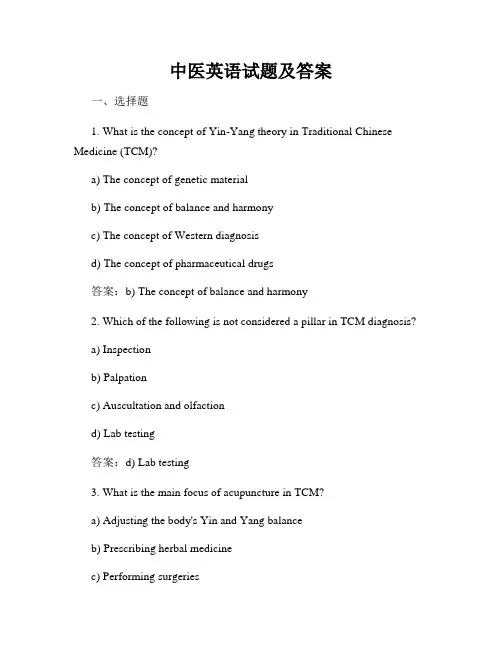
中医英语试题及答案一、选择题1. What is the concept of Yin-Yang theory in Traditional Chinese Medicine (TCM)?a) The concept of genetic materialb) The concept of balance and harmonyc) The concept of Western diagnosisd) The concept of pharmaceutical drugs答案:b) The concept of balance and harmony2. Which of the following is not considered a pillar in TCM diagnosis?a) Inspectionb) Palpationc) Auscultation and olfactiond) Lab testing答案:d) Lab testing3. What is the main focus of acupuncture in TCM?a) Adjusting the body's Yin and Yang balanceb) Prescribing herbal medicinec) Performing surgeriesd) Applying physical therapies答案:a) Adjusting the body's Yin and Yang balance4. What does the TCM term "Qi" refer to?a) Meridians in the bodyb) The five elements theoryc) The body's vital energyd) Herbal medicine ingredients答案:c) The body's vital energy5. Which of the following is a commonly used herb in TCM for reducing inflammation?a) Ginsengb) Licorice rootc) Ginkgo bilobad) St. John's Wort答案:b) Licorice root二、填空题1. Acupuncture is believed to restore the balance of ________ in the body.答案:Qi2. TCM diagnosis methods include inspection, palpation, ________ and olfaction.答案:auscultation3. The traditional Chinese herb ________ is commonly used for improving digestion.答案:ginger4. In TCM, the concept of "________" refers to the interaction between different body organs.答案:interconnectedness5. ________ exercises, such as Tai Chi and Qigong, are often recommended in TCM for promoting overall well-being.答案:Mind-body三、简答题1. Explain the concept of Yin and Yang in Traditional Chinese Medicine.答案:In TCM, Yin and Yang are two complementary forces that represent the balance and harmony in the body. Yin represents the cooler, more passive aspects, while Yang represents the hotter, more active aspects. The balance between Yin and Yang is crucial for maintaining optimal health. When Yin and Yang are imbalanced, it leads to illness. TCM treatments aim to restore the balance of Yin and Yang to promote overall well-being.2. Discuss the role of herbal medicine in Traditional Chinese Medicine.答案:Herbal medicine plays a significant role in TCM. Different herbs and natural substances are used to promote healing and restore balance in the body. Each herb has specific properties and functions that can be used totreat various conditions. Herbal prescriptions are tailored to an individual's specific needs, taking into account their unique symptoms and constitution. Herbal medicine can be used to address a wide range of health issues, from common colds to chronic diseases.3. Compare and contrast Traditional Chinese Medicine with Western medicine.答案:Traditional Chinese Medicine and Western medicine have different approaches to understanding and treating illnesses. TCM focuseson the holistic view of the body and aims to restore balance and harmony. It emphasizes natural healing methods, such as acupuncture, herbal medicine, and lifestyle adjustments. Western medicine, on the other hand, relies heavily on scientific research and evidence-based practices. It focuses on diagnosis, treatment, and prevention using pharmaceutical drugs, surgery, and advanced medical technologies.While both systems have their strengths and weaknesses, they can also complement each other. Many people choose to integrate both TCM and Western medicine for a comprehensive approach to healthcare.总结:中医英语试题主要包括选择题、填空题和简答题,涉及到中医理论、诊断方法和治疗手段等方面的内容。
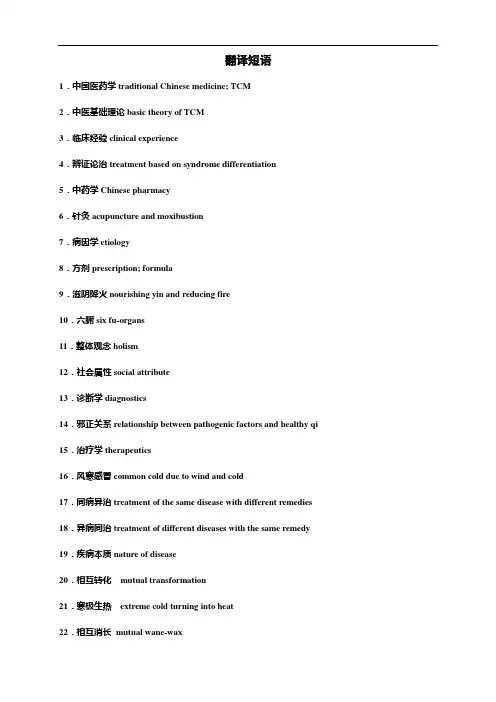
翻译短语1.中国医药学traditional Chinese medicine; TCM2.中医基础理论basic theory of TCM3.临床经验clinical experience4.辨证论治treatment based on syndrome differentiation5.中药学Chinese pharmacy6.针灸acupuncture and moxibustion7.病因学etiology8.方剂prescription; formula9.滋阴降火nourishing yin and reducing fire10.六腑six fu-organs11.整体观念holism12.社会属性social attribute13.诊断学diagnostics14.邪正关系relationship between pathogenic factors and healthy qi 15.治疗学therapeutics16.风寒感冒common cold due to wind and cold17.同病异治treatment of the same disease with different remedies 18.异病同治treatment of different diseases with the same remedy 19.疾病本质nature of disease20.相互转化mutual transformation21.寒极生热extreme cold turning into heat22.相互消长mutual wane-wax23.相互制约mutual restriction24.相互依存interdependence25.五行学说the doctrine of five elements26.相乘相侮subjugation and counter-restriction27.土虚木乘deficient earth being subjugated by wood28.生克制化inhibition-development with generation and restriction 29.母病及子involvement of a child- organ by its mother-organ disorder 30.藏象学说doctrine of visceral manifestations31.奇恒之腑extraordinary fu-organs32.水谷精微essence of water and food33.临床实践clinical practice34.藏而不泻storage without discharge/excretion35.心气充沛sufficiency of heart qi36.血液充盈sufficiency of blood37.汗血同源sweat and blood sharing the same origin38.脾主运化the spleen governing transportation and transformation 39.后天之本origin of acquired constitution40.奇恒之腑extraordinary fu-organs41.上焦upper energizer42.泌别清浊separating the lucid from the turbid43.初步消化primary digestion44.月经来潮occurrence of menstruation45.先天禀赋innateness46.水液代谢water metabolism47.气机调畅smoothness of qi movement48.气机qi movement49.气化qi transformation50.先天之气innate qi51.后天之气acquired qi52.气生血qi generating blood53.气行血qi propelling blood54.津血同源body fluid and blood sharing the same origin55.气为血帅,血为气母Qi serves as commander of blood and blood does as mother of qi 56.益气固脱nourishing qi to stop collapse57.经络学说meridian theory58.经络系统meridian system59.十二正经twelve regular meridians60.奇经八脉eight extraordinary meridians61.十二经别twelve meridians’divergences62.外感六淫six exogenous pathogenic factors63.风邪外袭pathogenic wind attacking the exterior64.感受寒邪attack/invade by pathogenic cold65.阴虚生内热production of endogenous heat due to yin deficiency66.七情内伤internal impairment due to seven emotions67.体质强弱(body )constitutional state68.五心烦热feverish sensation in the five centers (palms, soles, and chest)69.五志过极extreme changes of five emotions70.阴阳互损mutual involvement of yin and yang71.精充气足sufficient essence and abundant qi72.肌肤甲错squamous and dry skin73.预后良好favorable prognosis74.脉象pulse conations75.表里同病disease involving both exterior and interior76.寒热错杂co-existence of cold and heat/ mixture of cold and heat 77.真寒假热true cold with false heat78.寒证化热cold syndrome transforming into heat one79.热证转寒transformation of heat syndrome into cold one 80.潮热盗汗tidal fever and night sweating81.中草药Chinese medicinal herbs82.四气五味four properties and five flavors83.燥湿健脾drying dampness to invigorate the spleen84.升降沉浮ascending, descending, sinking and floating85.归经channel tropism of medicines86.用药禁忌medication contraindication87.方剂学science of prescription88.方剂的加减modification of a prescription89.剂型与剂量drug form and dosage90.药物毒性toxicity of medicinal herb91.引经报使guiding action92.药物饮片herbal slice93.针灸疗法acupuncture and moxibustion (therapy)94.针刺补泻reinforcing and reducing95针刺止痛analgesia by acupuncture96.针刺麻醉acupuncture anesthesia97.耳针疗法ear acupuncture (therapy)98.提插捻转lifting, thrusting, twisting and rotating (techniques)翻译句子1.中国医药学有数千年的历史,是中国人民长期同疾病作斗争的经验总结。
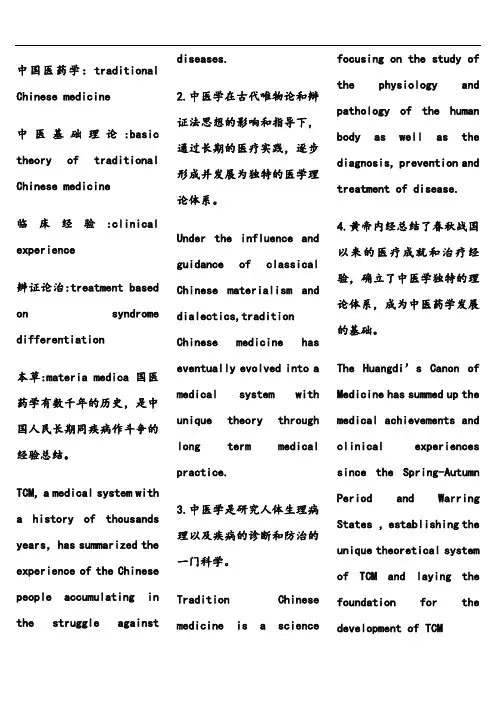
中国医药学:traditional Chinese medicine中医基础理论:basic theory of traditional Chinese medicine临床经验:clinical experience辨证论治:treatment based on syndrome differentiation本草:materia medica国医药学有数千年的历史,是中国人民长期同疾病作斗争的经验总结。
TCM, a medical system with a history of thousands years,has summarized the experience of the Chinese people accumulating in the struggle against diseases.2.中医学在古代唯物论和辩证法思想的影响和指导下,通过长期的医疗实践,逐步形成并发展为独特的医学理论体系。
Under the influence andguidance of classicalChinese materialism anddialectics,traditionChinese medicine haseventually evolved into amedical system withunique theory throughlong term medicalpractice.3.中医学是研究人体生理病理以及疾病的诊断和防治的一门科学。
Tradition Chinesemedicine is a sciencefocusing on the study ofthe physiology andpathology of the humanbody as well as thediagnosis, prevention andtreatment of disease.4.黄帝内经总结了春秋战国以来的医疗成就和治疗经验,确立了中医学独特的理论体系,成为中医药学发展的基础。
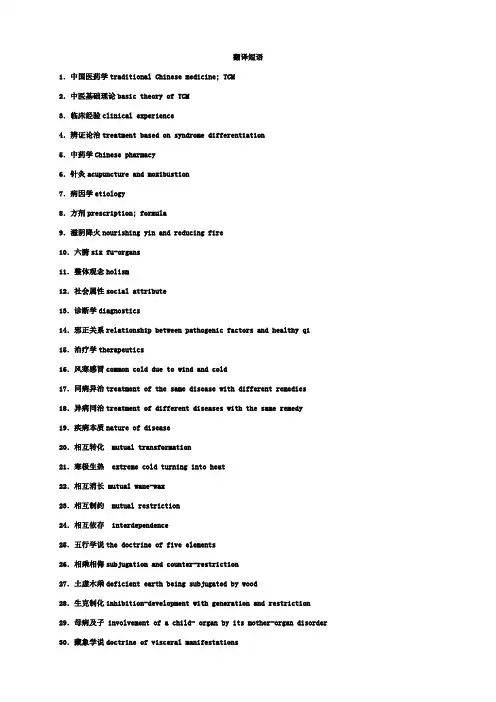
翻译短语1.中国医药学traditional Chinese medicine; TCM2.中医基础理论basic theory of TCM3.临床经验clinical experience4.辨证论治treatment based on syndrome differentiation5.中药学Chinese pharmacy6.针灸acupuncture and moxibustion7.病因学etiology8.方剂prescription; formula9.滋阴降火nourishing yin and reducing fire10.六腑six fu-organs11.整体观念holism12.社会属性social attribute13.诊断学diagnostics14.邪正关系relationship between pathogenic factors and healthy qi 15.治疗学therapeutics16.风寒感冒common cold due to wind and cold17.同病异治treatment of the same disease with different remedies 18.异病同治treatment of different diseases with the same remedy19.疾病本质nature of disease20.相互转化 mutual transformation21.寒极生热 extreme cold turning into heat22.相互消长 mutual wane-wax23.相互制约 mutual restriction24.相互依存 interdependence25.五行学说the doctrine of five elements26.相乘相侮subjugation and counter-restriction27.土虚木乘deficient earth being subjugated by wood28.生克制化inhibition-development with generation and restriction 29.母病及子 involvement of a child- organ by its mother-organ disorder 30.藏象学说doctrine of visceral manifestations31.奇恒之腑extraordinary fu-organs32.水谷精微essence of water and food33.临床实践clinical practice34.藏而不泻storage without discharge/excretion35.心气充沛sufficiency of heart qi36.血液充盈sufficiency of blood37.汗血同源sweat and blood sharing the same origin38.脾主运化the spleen governing transportation and transformation39.后天之本origin of acquired constitution40.奇恒之腑extraordinary fu-organs41.上焦upper energizer42.泌别清浊separating the lucid from the turbid43.初步消化 primary digestion44.月经来潮occurrence of menstruation45.先天禀赋innateness46.水液代谢water metabolism47.气机调畅smoothness of qi movement48.气机qi movement49.气化qi transformation50.先天之气innate qi51.后天之气acquired qi52.气生血qi generating blood53.气行血qi propelling blood54.津血同源body fluid and blood sharing the same origin55.气为血帅,血为气母Qi serves as commander of blood and blood does as mother of qi 56.益气固脱nourishing qi to stop collapse57.经络学说meridian theory58.经络系统meridian system59.十二正经twelve regular meridians60.奇经八脉eight extraordinary meridians61.十二经别twelve meridians’ divergences62.外感六淫six exogenous pathogenic factors63.风邪外袭pathogenic wind attacking the exterior64.感受寒邪attack/invade by pathogenic cold65.阴虚生内热production of endogenous heat due to yin deficiency66.七情内伤internal impairment due to seven emotions67.体质强弱 (body )constitutional state68.五心烦热feverish sensation in the five centers (palms, soles, and chest) 69.五志过极extreme changes of five emotions70.阴阳互损mutual involvement of yin and yang71.精充气足 sufficient essence and abundant qi72.肌肤甲错squamous and dry skin73.预后良好favorable prognosis74.脉象pulse conations75.表里同病disease involving both exterior and interior76.寒热错杂co-existence of cold and heat/ mixture of cold and heat77.真寒假热true cold with false heat78.寒证化热cold syndrome transforming into heat one79.热证转寒transformation of heat syndrome into cold one80.潮热盗汗tidal fever and night sweating81.中草药Chinese medicinal herbs82.四气五味four properties and five flavors83.燥湿健脾drying dampness to invigorate the spleen84.升降沉浮ascending, descending, sinking and floating85.归经channel tropism of medicines86.用药禁忌medication contraindication87.方剂学science of prescription88.方剂的加减modification of a prescription89.剂型与剂量drug form and dosage90.药物毒性toxicity of medicinal herb91.引经报使guiding action92.药物饮片 herbal slice93.针灸疗法acupuncture and moxibustion (therapy)94.针刺补泻reinforcing and reducing95针刺止痛analgesia by acupuncture96.针刺麻醉acupuncture anesthesia97.耳针疗法ear acupuncture (therapy)98.提插捻转lifting, thrusting, twisting and rotating (techniques)翻译句子1.中国医药学有数千年的历史,是中国人民长期同疾病作斗争的经验总结。
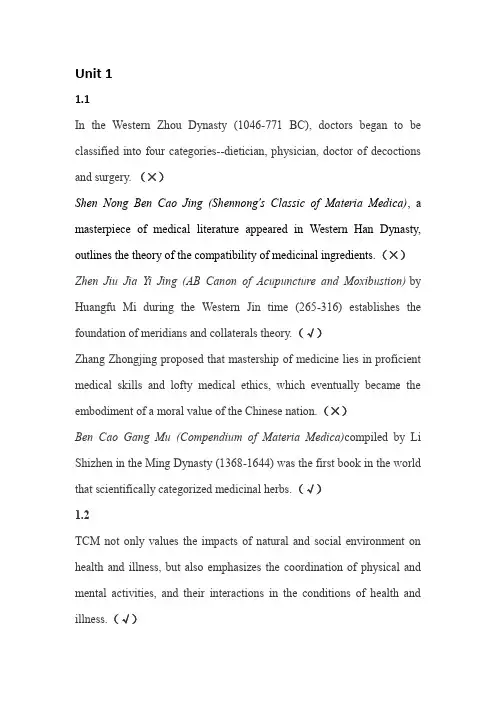
Unit 11.1In the Western Zhou Dynasty (1046-771 BC), doctors began to be classified into four categories--dietician, physician, doctor of decoctions and surgery.(×)Shen Nong Ben Cao Jing (Shennong's Classic of Materia Medica), a masterpiece of medical literature appeared in Western Han Dynasty, outlines the theory of the compatibility of medicinal ingredients.(×)Zhen Jiu Jia Yi Jing (AB Canon of Acupuncture and Moxibustion)by Huangfu Mi during the Western Jin time (265-316) establishes the foundation of meridians and collaterals theory.(√)Zhang Zhongjing proposed that mastership of medicine lies in proficient medical skills and lofty medical ethics, which eventually became the embodiment of a moral value of the Chinese nation.(×)Ben Cao Gang Mu (Compendium of Materia Medica)compiled by Li Shizhen in the Ming Dynasty (1368-1644) was the first book in the world that scientifically categorized medicinal herbs.(√)1.2TCM not only values the impacts of natural and social environment on health and illness, but also emphasizes the coordination of physical and mental activities, and their interactions in the conditions of health and illness.(√)The core concept of principle of harmony in TCM holds that a person's physical health mostly depends on harmony in the functions of the various body organs.(×)TCM therapies focus on the illness that the patient contracts rather than the person who is sick.(×)Principle of emphasis on individuality means the physicians should take full consideration of the individual constitution.(√)Preventative treatment is a core belief of TCM, which lays great emphasis on prevention before a disease arises, guarding against pathological changes when falling sick, and protecting recovering patients from relapse.(√)Unit 22.1In their origin the concepts, Yin and Yang were very simple. The aspect that faced the sun was (yang), and the aspect that faced away from the sun was (yin).Anything partaking of the characteristics of the heaven, the sun, warmth, brightness, daytime, fire, male, generation, etc. belong to (yang).The basic contents of yin-yang theory include four principles: (mutual opposition and restraint between Yin and Yang)、(mutual dependence and support between Yin and Yang)、(equilibrium andwaning-waxing of Yin and Yang)、(mutual transformation of Yin and Yang).Anything partaking of the characteristics of the earth, the moon, cold, darkness, nighttime, water, female, death, etc. is Yin(√)The yin and yang aspects within an object are not in a static state, but in the process of change. This principle is called equilibrium and waning-waxing of Yin and Yang.(√)2.2According to Yin-yang theory,the exterior of the body is associated with (yang), while the interior is associated with (yin); the back is considered (yang) and the front is (yin); the six fu organs are considered (yang) while the five zang organs are (yin).Yin-yang theory can be used to describe the human physiologic processes,the various functional activities of the body belong to (yang), and all material bases for the vital functions, including essence, blood and body fluids, belong to (yin).According to yin-yang theory, the general principles in treatment include:“if cold warm it”; “(if hot cool it)”; “if deficient augment it”; “(if excessive purge it)” and“treat yin for yang diseases, and (treat yang for yin disorders).人生有形,不离阴阳The theory of Yin and Yang holds that the human body is an organic whole and a very complicated unity of Yin and Yang.All the organizational structures of human beings are not only organically related, but also can be divided into two parts: Yin and Yang which are opposite to each other.善诊者,必先察色按脉,以辨阴阳If one is good at diagnosis, they should differentiate the yin from yang after the observation of color (of complexion, tongue, urine, stool, etc.) and feeling the pulse.Unit 33.1By employing the method of“classifying by analogy”,the ancients established extensive connection between the five elements and the human body. The wood corresponds to the liver, the gallbladder, the eyes and the tendons. The fire corresponds to the heart, the large intestine, the tongue and the vessels.(×)The over-restraint cycle refers to the reversal of restraint, in which the suppressed turns about and suppresses its suppressor.(×)Generation and restraint cycles are normal relationships among the five elements, while over-restraint and counter-restraint cycles are abnormal ones.(√)汉译英:相生、相克、相乘、相侮Generation、Restraint、Over-restraint、Counter-restraint汉译英:土爰稼穑;木曰曲直Earth is the sowing and reaping、Wood is the bending and the straightening3.2The liver belongs to Wood. Thus, the liver likes to function smoothly and dislikes being blocked, and it has the capacity to ensure the smooth flow of qi and blood.(√)When a heart disorder affects the liver or a kidney disorder affects the lung, we call it “disorder in the mother affecting the child”.(×)The pattern of “the liver over-restraining the spleen” refers to stagnation of liver-qi creating failure of the spleen to regulate transportation and transformation.(√)汉译英:见肝之病,知肝传脾,必先实其脾气When the liver is diseased, the liver will transmit to the spleen, and so one should replenish the qi of the spleen.汉译英:培土生金法Cultivating the earth in order to generate metal.Unit 44.1The term “Zang” in chinese medicine refers to? AThe heart is called ( ) in Zang-fu theory of chinese medicine. D The lungs are called () in Zang-fu theory of chinese medicine. AThe triple-energizers are called ( ) in Zang-fu theory of chinese medicine. BWhich formulas can we use in Chinese Medicine to treat “Shen” diseases? ABCD4.2The relationship of heart and spleen centers on ( ) BThe relationship of lungs and kidney centers on ( ) A Depression of liver qi usually affects ( ) AThe relationship of heart and lungs can also be called ( ) B The relationship of heart and kidney can also be called ( ) CUnit 55.1The meridians and collaterals are pathways alongwhich ( ) circulate through the whole body. DThe twelve divergent meridians originate from the( ) AThe tertiary collaterals refer to the ( ) AThe meridian-collateral system consists of ( ) ABCAccording to the description, the meridians are classified into categories including ( ) BCD5.2Which meridians go up from the end of the fingers to the head?()AWhich meridians ascend from the toes to the abdomen and chest?()DWhich meridians come out of the axillae without exception ()B Which of the followings about the exterior-interior relations between the Twelve Meridians are correct?() ABCUnit 66.1In Chinese Medicine theory, what explains all physiologic activities of our body? () DIn the human body, qi appears in various forms. The basic form is()AThe qi that forms the blood and flows with it in the vessels, helping to nourish the entire body, is known as () BAccording to the description, which one of the followings are the functions of Nutritive qi? DThe qi that flows outside the vessels is known as()A6.2According to the description, which of the followings are correct? () ABCDAccording to the description, which of the followings about blood heat are correct? () ABCDIf blood stagnation affects the heart, what kind of symptoms usually may be found? () ABCDAccording to the description, which of the followings are correct? () ABCDAccording to the description, which of the followings are correct? () ABCD6.3According to the description, which of the followings are correct? ( ) ABCDAccording to the description, which of the followings are correct? ( ) ABCDAccording to the description, which of the followings are correct? ( ) ABCDAccording to the description, which of the followings are correct? ( ) ABCDAccording to the description, which of the followings are correct? ( ) ABCDUnit 77.1Si x excesses refer to (wind、cold、summerheat、dampness、dryness、fire)____comes and goes quickly, moves swiftly, blows intermittently, and sways the branches of the trees. (Wind)When____evil invades the exterior, the patient may complain of physical fatigue, heavy, cumbersome limbs, and heavy headedness. If it invades the channels and the joints, the patient may complain of aching joints and inhibited bending and stretching. (dampness)Fire is characterized by fluctuating generalized fever; fatigued limbs; loss of appetite; oppression in the chest; nausea and vomiting; abnormal stool; short voidings of reddish urine; soggy pulse; and thick, slimy tongue fur.(×)Dryness as an evil has characteristics of environmental phenomenon of dryness. Dryness that invades the body from the outside is known as external dryness, and normally occurs in dry regions or in dry weather.(√)7.2____ include dietary irregularities, sexual intemperance and taxation fatigue, external injuries, parasites, and others. (Neutral causes)____arises as a result of either the impaired movement and transformation of fluids associated with morbidity of the lung, spleen, and kidney, or the "boiling" of the fluids by depressed fire.(Phlegm)____refers to generalized impairment of the smooth flow of blood, local stagnation of blood in the vessels, or local accumulation of extravasated blood.(Blood stasis)Dietary irregularities may not only affect the spleen and the stomach, causing digestive disturbances, food accumulation, stomach pain, diarrhea, but in cases of excessive liquor consumption and overindulgence in sweet and fatty foods, dietary irregularity may create heat, phlegm, and dampness.(√)Generalized signs of blood stasis include a dull, stagnant facial complexion, green-blue or purple lips and tongue, and stasis macules on the edge of the tongue. The pulse is fine or rough. (√)Unit 88.1F our examinations refer to________________(inspection、listening and smelling、inquiry、palpation)____refers to a combination of the patient’s facial expression, complexion, bearing, quality of voice, enunciation and verbal expression, and consciousness.(Inspecting the spirit)____can objectively reflects the state of qi and blood, progress and regression of diseases, the degree of heat and blood, and the depth of penetration of evils.(The tongue)The smell of the patient’s breath and excreta can give some indication of their conditions, such as: halitosis, pus, fishy smell. (√)Changes in voice and breathing are direct reflection of disease changes in the lung.(√)8.2____is an important way for the physician to get information about the patient’s condition.(Inquiry)____refers to the process of examining the surface of the body by touching to detect the presence of diseases.(Palpation)____ involves feeling the pulsation of the blood vessels by placing the finger tips on the surface of the body.(Pulse examination)Inquiry in TCM includes cold and heat, sweat, stool and urine, diet and taste in the mouth, chest and abdomen, hearing and vision, attitudes, emotions, lifestyle, and working environment, gynecological matters and children.(√)General palpation includes palpation of the skin, the chest, the abdomen, the limbs and the bones.(×)期末(温馨提示:期末考卷,由于没有显示正确答案,以下答案纯属本人亲测,正确率77.1%)CCDCB DDCDC DBABC ABCBCABC ABC ABCE ABCDE BCDABCDE ABCD ACDE ABCD ABCDE×√√√√√×√××DCBBB DCACB CB √×√√√√√√。
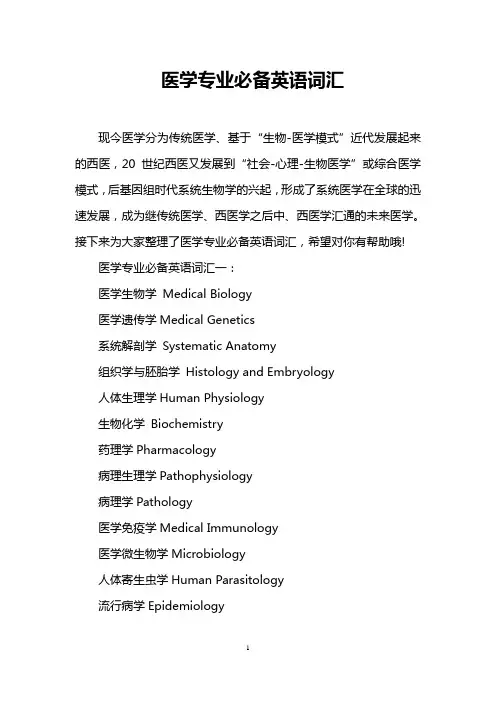
医学专业必备英语词汇现今医学分为传统医学、基于“生物-医学模式”近代发展起来的西医,20世纪西医又发展到“社会-心理-生物医学”或综合医学模式,后基因组时代系统生物学的兴起,形成了系统医学在全球的迅速发展,成为继传统医学、西医学之后中、西医学汇通的未来医学。
接下来为大家整理了医学专业必备英语词汇,希望对你有帮助哦!医学专业必备英语词汇一:医学生物学Medical Biology医学遗传学Medical Genetics系统解剖学Systematic Anatomy组织学与胚胎学Histology and Embryology人体生理学Human Physiology生物化学Biochemistry药理学Pharmacology病理生理学Pathophysiology病理学Pathology医学免疫学Medical Immunology医学微生物学Microbiology人体寄生虫学Human Parasitology流行病学Epidemiology卫生学Hygiene局部解剖学Regional Anatomy法医学Forensic Medicine实验诊断学Laboratory Diagnosis诊断学Diagnostics内科学Internal Medicine外科学Surgery妇产科学Obstetrics and Gynecology儿科学Pediatrics神经病学Neurology精神病学Psychiatry康复医学Rehabilitation Medicine中医学Chinese Traditional Medicine皮肤与性病学Dermatology and Venerology 传染病学Infectious Diseases核医学Atomic Medicine口腔解剖生理学Oral Anatomy and Physiology 口腔组织病理学Oral Histology and Pathology 口腔粘膜病学Diseases of the Oral Mucosa牙体牙髓病学Cariology And Endodontics牙周病学Periodontics口腔正畸学Orthodontics口腔修复学Prosthodontics口腔颌面外科学Oral And Maxillofacial Surgery口腔预防医学及儿童口腔医学PDPD麻醉解剖学Anesthesia Anatomy麻醉物理学Anaesthetic Physics临床麻醉学Clinical Anaesthesiology重症监护Intensive Care Therapy疼痛诊疗学Diagnosis and Treatment of Pain麻醉设备学Anesthesia Equipment医学影像学Medical Imaging影像物理学Physics of Medicine Imaging医学专业必备英语词汇二:生物药剂学与药物动力学Biopharmaceutics and Pharmacokinetics生药学Pharmacognosy天然药物化学Natural Medicine Chemistry药剂学Pharmaceutics药事管理学The Science of Pharmacy Administration护理学基础Fundamental Nursing儿科护理学Paediatric nursing内科护理学Medical Nursing外科护理学Surgical Nursing护理管理学Science of Nursing Management护理心理学Nursing Psychology急诊护理学Emergency Nursing医用物理学Medical Physics数学Mathematics体育Physical Education计算机Computer Science毛泽东思想概论Essentials of Mao Zedong Thought 邓小平理论Deng Xiao Ping Theory政治经济学Political Economy马克思主义哲学Marxism Philosophy法律基础Basis of Law医学伦理学Medicine Ethics医学心理学Medical Psychology市场营销Marketing会计学Accounting影像设备学Medical Imaging Equipment医用电子学Medical Electronics超声诊断Ultrasonic Diagnosis眼科学Ophthalmology基础眼科学Fundamental Ophthalmology临床眼科学Clinical Ophthalmology眼科手术学Ophthalmic Operative Surgery 眼科诊断学Ophthalmologic Diagnostics 耳鼻咽喉科学Otorhinolaryngology无机化学Inorganic Chemistry有机化学Organic Chemistry分析化学Analytical Chemistry物理化学Physical Chemistry仪器分析Instrumental Analysis药物化学Medicinal Chemistry药物分析Pharmaceutical Analysis。
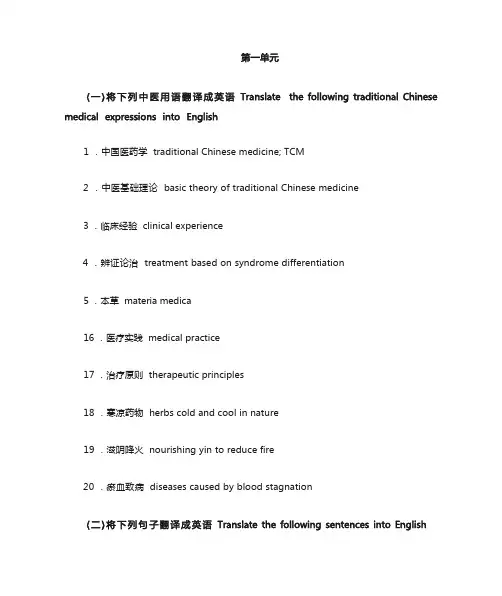
1 .中国医药学 traditional Chinese medicine; TCM2 .中医基础理论 basic theory of traditional Chinese medicine3 .临床经验 clinical experience4 .辨证论治 treatment based on syndrome differentiation5 .本草 materia medica16 .医疗实践 medical practice17 .治疗原则 therapeutic principles18 .寒凉药物 herbs cold and cool in nature19 .滋阴降火 nourishing yin to reduce fire20 .瘀血致病 diseases caused by blood stagnation1 .中国医药学有数前年的历史,是中国人民长期同疾病作斗争的经验总结。
TCM, a medical system with a history of thousands of years is the summary of the experience of the Chinese people accumulating in their struggle against disease.2.中医学在古代唯物论和辩证法思想的影响和指导下,通过长期的医疗实践,逐步形成并发展成为独特的医学理论体系。
Under the guidance of classic materialism and dialectics, TCM has eventually evolved into a unique medical system through long term medical practice.3 .中医学是研究人体生理、病理以及疾病的诊断和防治的一门科学。
TCM is a science focusingon the study of physiology andpathology as well as diagnosis, prevention and treatment of diseases.4.《黄帝内经》总结了春秋战国以来的医疗成就和治疗经验,确立了中医学的独特的理论体系,成为中医药学发展的基础。
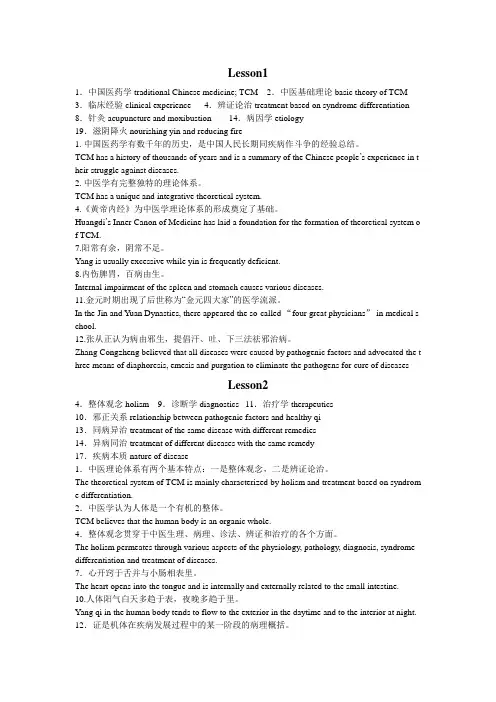
Lesson11.中国医药学traditional Chinese medicine; TCM 2.中医基础理论basic theory of TCM 3.临床经验clinical experience 4.辨证论治treatment based on syndrome differentiation 8.针灸acupuncture and moxibustion 14.病因学etiology19.滋阴降火nourishing yin and reducing fire1. 中国医药学有数千年的历史,是中国人民长期同疾病作斗争的经验总结。
TCM has a history of thousands of years and is a summary of the Chinese people’s experience in t heir struggle against diseases.2. 中医学有完整独特的理论体系。
TCM has a unique and integrative theoretical system.4.《黄帝内经》为中医学理论体系的形成奠定了基础。
Huangdi’s Inner Canon of Medicine has laid a foundation for the formation of theoretical system of TCM.7.阳常有余,阴常不足。
Yang is usually excessive while yin is frequently deficient.8.内伤脾胃,百病由生。
Internal impairment of the spleen and stomach causes various diseases.11.金元时期出现了后世称为“金元四大家”的医学流派。
In the Jin and Yuan Dynasties, there appeared the so-called “four great physicians” in medical s chool.12.张从正认为病由邪生,提倡汗、吐、下三法祛邪治病。
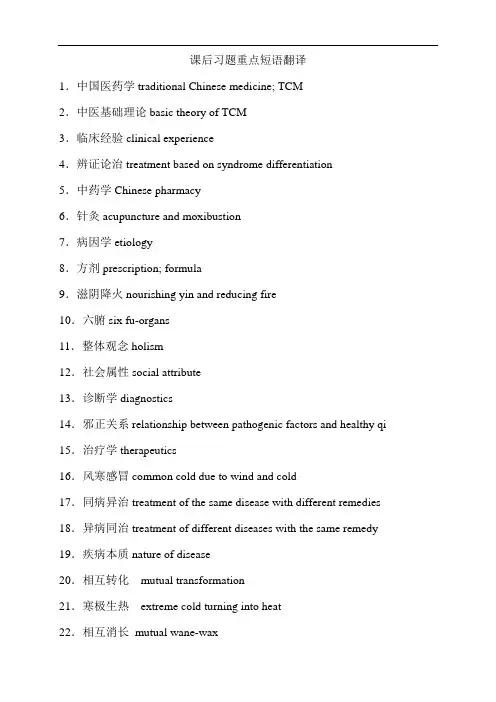
课后习题重点短语翻译1.中国医药学traditional Chinese medicine; TCM2.中医基础理论basic theory of TCM3.临床经验clinical experience4.辨证论治treatment based on syndrome differentiation5.中药学Chinese pharmacy6.针灸acupuncture and moxibustion7.病因学etiology8.方剂prescription; formula9.滋阴降火nourishing yin and reducing fire10.六腑six fu-organs11.整体观念holism12.社会属性social attribute13.诊断学diagnostics14.邪正关系relationship between pathogenic factors and healthy qi 15.治疗学therapeutics16.风寒感冒common cold due to wind and cold17.同病异治treatment of the same disease with different remedies 18.异病同治treatment of different diseases with the same remedy 19.疾病本质nature of disease20.相互转化mutual transformation21.寒极生热extreme cold turning into heat22.相互消长mutual wane-wax23.相互制约mutual restriction24.相互依存interdependence25.五行学说the doctrine of five elements26.相乘相侮subjugation and counter-restriction27.土虚木乘deficient earth being subjugated by wood28.生克制化inhibition-development with generation and restriction 29.母病及子involvement of a child- organ by its mother-organ disorder 30.藏象学说doctrine of visceral manifestations31.奇恒之腑extraordinary fu-organs32.水谷精微essence of water and food33.临床实践clinical practice34.藏而不泻storage without discharge/excretion35.心气充沛sufficiency of heart qi36.血液充盈sufficiency of blood37.汗血同源sweat and blood sharing the same origin38.脾主运化the spleen governing transportation and transformation 39.后天之本origin of acquired constitution40.奇恒之腑extraordinary fu-organs41.上焦upper energizer42.泌别清浊separating the lucid from the turbid43.初步消化primary digestion44.月经来潮occurrence of menstruation45.先天禀赋innateness46.水液代谢water metabolism47.气机调畅smoothness of qi movement48.气机qi movement49.气化qi transformation50.先天之气innate qi51.后天之气acquired qi52.气生血qi generating blood53.气行血qi propelling blood54.津血同源body fluid and blood sharing the same origin55.气为血帅,血为气母Qi serves as commander of blood and blood does as mother of qi56.益气固脱nourishing qi to stop collapse57.经络学说meridian theory58.经络系统meridian system59.十二正经twelve regular meridians60.奇经八脉eight extraordinary meridians61.十二经别twelve meridians’divergences62.外感六淫six exogenous pathogenic factors63.风邪外袭pathogenic wind attacking the exterior64.感受寒邪attack/invade by pathogenic cold65.阴虚生内热production of endogenous heat due to yin deficiency66.七情内伤internal impairment due to seven emotions67.体质强弱(body )constitutional state68.五心烦热feverish sensation in the five centers (palms, soles, and chest) 69.五志过极extreme changes of five emotions70.阴阳互损mutual involvement of yin and yang71.精充气足sufficient essence and abundant qi72.肌肤甲错squamous and dry skin73.预后良好favorable prognosis74.脉象pulse conations75.表里同病disease involving both exterior and interior76.寒热错杂co-existence of cold and heat/ mixture of cold and heat 77.真寒假热true cold with false heat78.寒证化热cold syndrome transforming into heat one79.热证转寒transformation of heat syndrome into cold one80.潮热盗汗tidal fever and night sweating81.中草药Chinese medicinal herbs82.四气五味four properties and five flavors83.燥湿健脾drying dampness to invigorate the spleen84.升降沉浮ascending, descending, sinking and floating85.归经channel tropism of medicines86.用药禁忌medication contraindication87.方剂学science of prescription88.方剂的加减modification of a prescription89.剂型与剂量drug form and dosage90.药物毒性toxicity of medicinal herb91.引经报使guiding action92.药物饮片herbal slice93.针灸疗法acupuncture and moxibustion (therapy)94.针刺补泻reinforcing and reducing95针刺止痛analgesia by acupuncture96.针刺麻醉acupuncture anesthesia97.耳针疗法ear acupuncture (therapy)98.提插捻转lifting, thrusting, twisting and rotating (techniques)99.热证转寒heat syndrome transforming into cold syndrome100舌淡苔白而润滑pale tongue with white, moist and slippery fur101.脉数无力rapid and weak pulse102.潮热盗汗tidal fever and night sweating103.神昏谵语coma with delirium104. 疾病的发生发展与变化occurrence, development, and changes of disease 105. 体质强弱(body )constitutional state106. 气血功能紊乱dysfunction of qi and blood107.多种多样的病理变化various pathological changes108. 邪正盛衰exuberance or decline of pathogenic factors and healthy qi/ strength contrast bet ween pathogenic factors and healthy qi109. 病症的虚实变化deficiency or excess changes of disease /transformation between deficiency and excess during a disease句型翻译1.中国医药学有数千年的历史,是中国人民长期同疾病作斗争的经验总结。
(完整word版)基础医学英语词汇常见医学单词:BSL Blood Sugar Level 血糖水平anti-coagulation 抗凝CHF Congestive Heart Failure 充血性心力衰竭constrict / constriction 收缩RBC Red Blood Celldilate / dilation 舒张WBC White Blood Cellnegative 阴性Platelet 血小板positive 阳性Plasma/serum 血浆myocardium 心肌Consciousness 意识coronary artery 冠状动脉Hypoxia 缺氧ventricle 心室Osmotic pressure 渗透压atrium 心房Colloid Osmotic pressure 胶体渗透压blood supply 血供Spinal column 脊柱BT bleeding time 出血时间Acidosis 酸中毒Alkalosis 碱中毒CT clotting time 凝血时间Pulmonary edema 肺水肿water-soluble 水溶性nerve 神经fat-soluble 脂溶性Oxygen 氧气pulmonary arterial / vein肺动/静脉Carbon dioxide 二氧化碳elastic 有弹性的Stomach 胃tissue 组织Gastric contents 胃内容物aorta 主动脉Risk factor 危险因素exchange 交换Flushed skin 皮肤发红gallbladder 胆囊Pallor 苍白lung 肺Dizziness 头晕kidney 肾Nausea 恶心cardiac output 心输出量V omit 呕吐peripheral resistance 外周阻力Seizure 惊厥systolic blood pressure 收缩压Enema 灌肠diastolic blood pressure 舒张压Electrolyte 电解质normal range 正常范围Fluid and electrolyte imbalance 水电解质紊乱capillary 毛细血管BUN blood urea nitrogen血尿素氮circulatory system 循环系统Blood gas 血气release 释放Hormone 激素superficial 表浅的Protein 蛋白质blood volume 血容量Albumin 白蛋白bradycardia 心动过缓Glucose 葡萄糖tachycardia 心动过速Hemoglobin 血红蛋白valve 瓣膜Sternum 胸骨forearm 前臂Rib 肋骨breast 胸部,乳房Liver 肝armpit 腋窝Spleen 脾groin 腹股沟Pancreas 胰腺prevent 预防Iron 鉄bloodstream 血流Calcium 钙fiber 纤维Magnesium 镁acute 急性的Sodium 钠diarrhea 腹泻Potassium 钾Antibody-antigen complex 抗原抗体复合物Bone marrow 骨髓myocardial infarctionTransplant 移植low-grade fever 低热Blurred vision 视力模糊chill 寒战Spontaneous 自主的urticaria 风疹Dysrhythmia 心律不齐inhibitor 抑制剂GI irritation 胃肠刺激inflammation 炎症Intake and output 出入量angioplasty 血管扩张术Hypokalemia 低血钾normal saline 生理盐水Hyperkalemia 高血钾circulatory overload 循环负担过重Hypotension 低血压shortness of breath 气短Hypertension 高血压restless 烦躁不安Antihypertensive 抗高血压药rapid and thready pulse 脉搏细速Headache 头痛orthopnea 端坐呼吸Urinary retention 尿储留pallor/ cyanosis 苍白Angina pectoris 心绞痛chest paincentral venous pressure 中心静脉压Sublingual 舌下的Fowler’s position 端座卧位Oral 口服的Semi- Fowler’s position 半座卧位Topical 局部的dyspnea 呼吸困难Calcium channel blocker 钙离子通道阻滞剂diuretics 利尿剂Mucosa 粘膜impaired 受损的Orthostatic hypotension 体位性低血压pink and frothy sputum粉红色泡沫样痰Hypoglycemia 低血糖yellow sputum 黄痰Hyperglycemia 高血糖blood-streaked sputum 血丝痰Hypovolemia 低血容量mucoid sputum 黏液痰Hypervolemia 高血容量breathing pattern 呼吸模式Preload and afterload (心脏的)前后负荷sterile 无菌的Dehydration 脱水container 容器Uric acid 尿酸cool clammy skin 皮肤湿冷Sign 体征preventive 预防性的Symptom 症状bronchitis 支气管炎Symptom free/ asymptomatic 无症状pneumonia 肺炎Monitor 监测concentration 浓度Constipation 便秘barrel chest 桶状胸Skin rash 皮疹distended neck vein 颈静脉怒张Heparin 肝素external irritant 外界刺激物Warfarin 华法林endocrine system 内分泌系统Hemorrhage 大出血insulin 胰岛素Therapy 疗法absorption 吸收Alcohol 酒精reabsorption 再吸收Anemia 贫血shock 休克Folic acid 叶酸trauma 外伤Allergic reaction 过敏反应complication 并发症Bile 胆汁compensatory 代偿的Bile acid 胆汁酸Cholesterol 胆固醇Obesity 肥胖症Stuffy nose 鼻塞collect sputum and blood specimen for culture and sensitivity tests 收集痰血标本做细菌培养和药敏COPD chronic obstructive pulmonary disease 慢性阻塞性肺疾病DM Diabetes Mellitus 糖尿病Gestational diabetes 妊娠糖尿病Ketone body 酮体Ketoacidosis 酮症酸中毒Insulin resistant 胰岛素耐受Carbohydrate 碳水化合物Mechanism 机制,机理IDDM (Type 1) insulin-dependant diabetes mellitue 胰岛素依赖性糖尿病NIDDM (Type 2) non-insulin-dependant diabetes mellitue非胰岛素依赖性糖尿病Glucose Tolerance Test 糖耐量试验Oral anti-diabetic medications 口服降糖药PVD peripheral vascular disease 外周血管病Arterioatherosclerosis 动脉粥样硬化CAD coronary artery disease 冠心病CVD cerebral vascular disease 脑血管病Polyuria 多尿Ulcer 溃疡Gangrene 坏疽Fatigue 疲乏Blurred vision 视力模糊Fasting blood sugar 空腹血糖2-hour post-prandial glucose 餐后两小时血糖Hemoglobin 血红蛋白Metabolic acidosis 代谢性酸中毒Respiratory acidosis 呼吸性酸中毒Ketonuria 酮尿Sweet breath odor 烂苹果味呼吸Mental confusion 精神错乱Slurred speech 说话含糊不清Wound healing 伤口愈合Renal function 肾功能Renal failure 肾衰Uremia 尿毒症Creatinine 肌酐Urea 尿素Internal 内部的External 外部的Itching 痒BUN blood urea nitrogen 血尿素氮Carbon dioxide combining power 二氧化碳结合力Urine gravity 尿比重Bleeding tendency 出血倾向Injury 外伤Patency 开放,通畅Bed sore 褥疮Skin care 皮肤护理Paraplegia 截瘫Pacemaker 起搏器Elevate 抬高Pitting edema 凹陷型水肿Sodium-restricted diet 限钠饮食Interstitial space 组织间隙Extremity 四肢,肢端Deficiency 缺乏,不足Blood transfusion 输血GI irritation 胃肠刺激Pleural space 胸膜腔Fluctuate 波动Kink 弯曲,折住Water-seal chamber 水封瓶Subcutaneous emphysema 皮下气肿Airtight 密封的Sharp pain 锐痛Dull pain 钝痛Burning pain 灼痛Radiating pain 放射痛各科室名称:medical department; department of internal medicine: 内科surgical department; department of surgery: 外科department of obstetrics and gynecology : 妇产科ophtalmology department: 眼科dental department: 牙科ENT(ear-nose-throat)department: 耳鼻喉科urology department: 泌尿科dermatology department; skin department: 皮肤科orthopedic surgery department: 矫形外科traumatology department: 创伤外科plastic surgery: 整形外科anesthesiology department: 麻醉科pathology department: 病理科cardiology department: 心脏病科psychiatry department: 精神病科orthopedics department: 骨科department of cardiac surgery: 心脏外科department of cerebral surgery: 胸外科neurology department: 神经科neurosurgery department: 神经外科thoracic surgery department: 脑外科department of traditional Chinese medicine: 中医科registration office: 挂号处out-patient department: 门诊部in-patient department: 住院部nursing department: 护理部consulting room: 诊室waiting room: 候诊室emergency room: 急诊室admitting office: 住院处operation room: 手术室X-ray department: 放射科blood bank: 血库dispensary; pharmacy: 药房ward: 病房laboratory: 化验室牤Department of Nephrology 肾内科Department of Chemotherapy 化疗科Department of Radiotherapy 放疗科Department of Endocrinology 内分泌科Respiratory medicine 呼吸科Rheumatology 风湿科Hematology 血液科Geriatrics 老年科Neurology 神经科Oncology 肿瘤科Thoracic surgery 胸外科Urology 泌尿外科Neurosurgery 神经外科Vascular surgery 周围血管外科Gastroenterology 肠胃外科Hepatobiliary surgery 肝胆外科General surgery 普外科Orthopedics 骨科Cardiovascular surgery 心外科Burns surgery 烧伤科Hand surgery 手外科Plastic surgery 整形外科Pediatric surgery 儿外科Obstetrics and gynecology 妇产科Stomatology 口腔科Ophthalmology 眼科Infectious disease 感染科Dermatology 皮肤科Otorhinolaryngology (ENT) 耳鼻喉科Nuclear medicine 核医学科Psychiatry 精神科Medical rehabilitation 康复科Anesthesiology 麻醉科Radiology 放射科Ultrasonography 超声科Pain management 疼痛科Pharmacology 药理科Internal Medicine 内科常见护理英语80句一.Receiving the patient(接待病人)1.How do you do? / Good morning!您好!(初次见面时使用)/早上好!2.What can I do for you? /Can I help you?您需要我帮助吗?3.I’ll bring you to your bedside, plea se follow me. This is your bed..我要领您到床边去.请跟我来.这是您的床位.4.The toilet is over there. 卫生间在那边5.We supply hot water. 我们供应热水6.Please wait a moment. I’ll let your doctor know. / I’ll inform your doctor.请等一会儿,我去通知医生.7.Mary is the nurse /doctor in charge of you.玛丽是您的负责护士/医生8.Please let us know if you need any help. 您需要帮助时,请告诉我们.9.Smoking is not allowed here.这里不允许吸烟二.information collection (收集信息)10.Do you mind if I ask you a few questions? 您介意我问您几个问题吗?11. We need some information from you. 我们需要从您这儿收集一些信息.12. Is your tummy still sore? 您的肚子还疼吗?13. Does your pain come on after or before meals? 您的疼痛是在饭前还是饭后发作?14. Does it hurt to pass urine? /when I press here? 排尿时痛吗?/ 当我按压这儿时痛吗?15. Does your back ache? 您的后背痛吗?16.Do your feet swell?您的脚肿了吗?17. Do you have a cough/fever? 您咳嗽吗?/ 您有发热吗?18. Do you bring up any sputum? 您咳痰吗?19. Is there any radiation of the pain? (to the shoulder)有放射(到肩部的)痛吗?20. How long have you had the pain? 您的痛有多长时间了?21. When did the pain start? /where is your pain? 疼痛从什么时候开始的/什么地方疼痛?22. Are your periods regular? 您的月经规则吗?三.Physical examination(查体)23.Will you please undress for medical examination? 请您脱下衣服做体检好吗?24. Take off your clothes, please. 请把衣服脱下来25.Lie down on the couch, please. /Just lie still on the couch and relax.请躺在治疗床上./ 请安静地躺在治疗床上,放松.26.Bend your knees, please. 请屈膝.27.Open your mouth and say ’ah" 张开口, 说: 啊28.Beathe deeply, please./take a deep breath, please.请深呼吸29.May I examine your tummy, please? 我要检查下您的肚子,好吗?30.Roll up your sleeves, please. 请卷起袖子.四.Communication. (交流)31.I am going to take your temperature./Please put the thermometer under your armpit.我要测一下您的体温/请把体温计放在您的腋下.32.Let me feel your pulse.让我测一下您的脉搏.33. I’ll test/take your blood pre ssure. 我要测量您的血压.34. I’m af raid I have to prick your finger and take a drop of blood for blood sugar level.我要取一滴指血做血糖测定, 需要刺一下手指.35. I’ll take some blood from your arm now. 现在我要从您的胳膊抽血.36. Don’t take any thing by mouth after midnight until the blood is drawn tomorrow morning.半夜之后不要吃喝任何东西,明天早上抽血.37. Please bring a specimen of your urine/stool/sputum./ please collect your mid-stream specimen of urine.请留一份尿/便/痰的标本/请收集您的中段尿.38. Please have your blood and urine tests done. 请做一下您的血和尿试验.39. You are going to have a CT-scan of your chest/head today.今天您要做一个胸部/头部CT.40. You are going to have a chest X-ray this morning. 今天早上您要拍一个胸片.41. You are going to have a B-mode ultrasonic exam. Please keep your bladder full.您要做B超检查,请留尿,使膀胱充盈.42. You are going to have an gastric endos copy tomorrow morning. Please don’t eat or drink anything after 12 o’clocktonight. 明天上午您要做胃镜检查,今晚12点之后,请不要吃喝任何东西。
1 总论序号汉文名英文名注释中医①traditional Chinese medicine②traditional Chinese physician ①中医学的简称。
②本学科专业职业队伍。
中药Chinese materia medica 在中医理论指导下应用的药物。
包括中药材、中药饮片和中成药等。
中医学traditional Chinese medicine 以中医药理论与实践经验为主体,研究人类生命活动中健康与疾病转化规律及其预防、诊断、治疗、康复和保健的综合性科学。
中药学Chinese materia medica 中药学科的统称。
研究中药基本理论和各种药材饮片、中成药的来源、采制、性能、功效、临床应用等知识的学科。
中医药traditional Chinese medicine and pharmacology 中医与中药的合称。
中医药学traditional Chinese medicine and pharmacology 中医学与中药学的合称,侧重反映中医与中药两者共同发展,密不可分。
中西医结合integration of traditional and western medicine 现代医学等现代科学知识及手段来继承和发展中医药,中西医学相互补充,取长补短,诊治疾病的医学形式。
中医基础理论basic theory of traditional Chinese medicine 研究和阐明中医学的基本概念、基本理论、基本规律、基本原则的学科。
中医诊断学diagnostics of traditional Chinese medicine 根据中医学的理论体系,研究诊察病情、判断病种、辨别证候的基础理论、基本知识和基本技能的学科。
方剂学prescriptions of Chinese materia medica 研究治法与方剂配伍规律及其临床运用的学科。
中医内科学internal medicine of traditional Chinese medicine 研究外感温病、内伤杂病等内科疾病诊治与预防的临床中医学。
Unit1 tumor: 肿瘤;肿块;赘生物 a mass of diseased cells in the body which divide and increased too
quikly
ailment:小病,不安 an illness that is not very serious
revival: 恢复精神;苏醒;再生效 a process in which something becomes active or strong again
integration:综合;集成 the combining of two or more things so that they work effectively normalize: 使正常化;使规格化,使标准化 standardize
well-deserved : ;理应的;当之无愧的 well-earned because of good or bad behavior, skill, work,
anesthesia:麻醉;麻木 the state of unable to feel pain
therapeutic:治疗的;治疗学的;有益于健康的 relating to the treatment or cure of an illness debilitate:使衰弱;使虚弱 make one ill or weak formula:公式,准则;配方;婴儿食品 a prescription of ingredients in fixed proportion turmoil:混乱,骚动 a state of confusion, excitement of anxiety deride:嘲笑;嘲弄 treat sb. Or sth. As funny and not worthy of serious attention pharmacological:药理学的 related to the scientific study of drugs and medicines treatise:论文;论述;专著 a serious of book or article about a particular subject nontoxic:无毒的 not poisonous to one’s health stagnation:停滞;滞止 a state of in active forebear:祖先;祖宗 ancestor inscribe:题写;题献;铭记;雕 careful cut, print, or write on sht. Esp on the surface of a stone or coin textB
aetiology:病因学;[基医] 病原学;原因论 the scientific study of the causes o fdisease ophthalmology:[眼科] 眼科学 medicine science dealing with disease illness of the eye beneficiary:受益人,受惠者;封臣 a person who gains as a result of sth. aromatic:芳香的,芬芳的;芳香族的 having a pleasant noticeable smell odour:气味;声誉 smell laxative:泻药;缓泻药,通便的 a drug tending to stimulate evacuation of the bowels alimentary:of food and digestion medicinal:药的;药用的;有益的;治疗的 helpful in the process of healing in illness semiology:记号学;记号语言;[临床] 症状学 symptomatology typhoid:伤寒的;斑疹伤寒症的a serious infections disease that cause fever, red spots on the chest
and severe pain in the bowels and sometimes causes death botanical:植物学的 relating to botany
paediatrics:[儿科] 儿科的;儿科学的 the branch of medicine concerned with children and their
disease otorhinolaryngology:耳鼻喉科学the study of disease of ear, nose, and throat
phytotherapy:本草疗法;植物疗法 the use of vegetable drugs in medicine pharmacopoeia:药典,处方书;一批备用药品 an official book containing a list of medicines and
drugs and instructions for their use
unit2 holistic :整体的;全盘的 consider a whole thing or being to be a collections of parts chronic:慢性的;长期的;习惯性的 recurring constantly conception:概念;设想;怀孕;开始 the action of conceiving a child of one being conceived
excess:无节制;过度,过量;超过,超额 an amount of sth that is more than nesessary
contract:感染;订约;收缩 become less or smaller ovum:[细胞][组织] 卵;卵子;卵形装饰 female egg-cell physiology:生理学;生理机能 the way the body of a person or an animal works practitioner:开业者,从业者 a person who woks in medicine anatomy:解剖学;剖析;[医]解剖;骨骼 scienctific study of the structure of animals bodies elimination:. 除去;消除;淘汰 getting grid of substances that one ‘s body no longer needs assimilation:吸收;[社会学]同化;[生理]同化作用 a conversion of nutriments into living tissue pathogen:病原体;病菌 something that causes disease in your body psyche:物理层;物理层协议soul and mind extremity:极端;绝境;非常手段;手足 limps syndrome:[临床] 综合征;综合症状;并发症状;校验子;并发位an illness which consists of a set
of physical or mental problems textB
stamina:精力;活力;毅力;持久力 physical or mental strenth sinewy:多腱的;有力的;肌肉发达的lean and muscular constitution:宪法;体质;章程;构造 condition of a person’s body with regard to health, strength,
etc. immunity:免疫力;免除;豁免an organism’s ability to resist a particular infection
symptom:征兆;症状 a change in one’s body or mind showing that one is not healthy moisture:潮湿;水分;降雨量;湿度 water or other liquid diffused in a small infection physique:体格,体形the form, size, and development of a person’s body circulation:流通,传播;循环;发行量 the movement of blood around the body dehydration:脱水loss of water from the body or from an organ or body part infection:感染;传染;传染病;影响 being ill through contact with bacteria digestion:消化;领悟 the process of digesting food hyperactive:极度活跃的;活动过度的 abnormally or extremely active
inadequacy:state of lacking the quality or quantity required
stressful:紧张的;有压力的 causing mental or emotional stress libido:性欲;生命力 emotional energy or urge, esp sexual
unit3 physiology: 生理学;生理机能the branch of biology that deals with the normal functions of living
organism and their parts induce: 引诱;[电]感应;[医]诱导;引起 bring about or giving rise to
interfere: 干涉;打扰;妨碍 prevent continuing or being carried out properly
fluid: 流动的;不固定的;流畅的 substance that has no fixed shape and yields easily to external
pressure